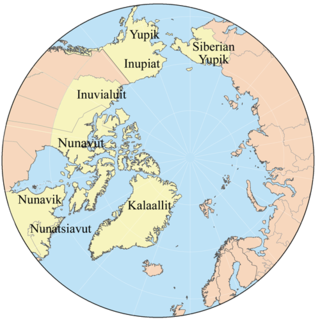
Eskimo is an exonym used to refer to two closely related Indigenous peoples: Inuit and the Yupik of eastern Siberia and Alaska. A related third group, the Aleut, which inhabit the Aleutian Islands, are generally excluded from the definition of Eskimo. The three groups share a relatively recent common ancestor, and speak related languages belonging to the Eskaleut language family.
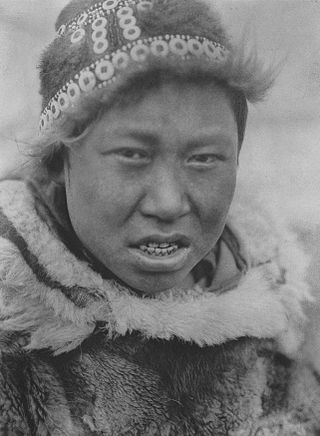
The Yupik are a group of Indigenous or Aboriginal peoples of western, southwestern, and southcentral Alaska and the Russian Far East. They are related to the Inuit and Iñupiat. Yupik peoples include the following:
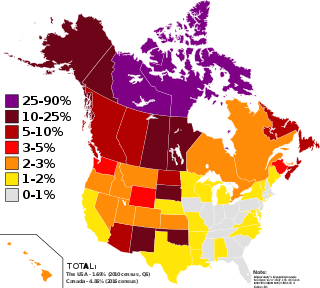
Indigenous peoples in Canada comprise the First Nations, Inuit, and Métis. Although Indian is a term still commonly used in legal documents, the descriptors Indian and Eskimo have fallen into disuse in Canada, and many consider them to be pejorative. Aboriginal peoples as a collective noun is a specific term of art used in some legal documents, including the Constitution Act, 1982, though in most Indigenous circles Aboriginal has also fallen into disfavour.

The Iñupiat are a group of Indigenous Alaskans whose traditional territory roughly spans northeast from Norton Sound on the Bering Sea to the northernmost part of the Canada–United States border. Their current communities include 34 villages across Iñupiat Nunaat, including seven Alaskan villages in the North Slope Borough, affiliated with the Arctic Slope Regional Corporation; eleven villages in Northwest Arctic Borough; and sixteen villages affiliated with the Bering Straits Regional Corporation. They often claim to be the first people of the Kauwerak.
First Nations is a term used to identify Indigenous peoples in Canada who are neither Inuit nor Métis. Traditionally, First Nations in Canada were peoples who lived south of the tree line, and mainly south of the Arctic Circle. There are 634 recognized First Nations governments or bands across Canada. Roughly half are located in the provinces of Ontario and British Columbia.

The Inuit Circumpolar Council (ICC), formerly Inuit Circumpolar Conference, is a multinational non-governmental organization (NGO) and Indigenous Peoples' Organization (IPO) representing the 180,000 Inuit, Yupik, and Chukchi peoples people living in Alaska, Canada, Greenland, and Chukotka (Russia). ICC was ECOSOC-accredited and was granted special consultative status at the UN in 1983.
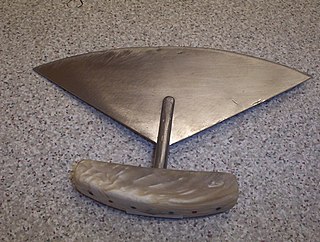
An ulu is an all-purpose knife traditionally used by Inuit, Iñupiat, Yupik, and Aleut women. It is used in applications as diverse as skinning and cleaning animals, cutting a child's hair, cutting food, and sometimes even trimming blocks of snow and ice used to build an igloo.
The Native American name controversy is an ongoing discussion about the changing terminology used by the Indigenous peoples of the Americas to describe themselves, as well as how they prefer to be referred to by others. Preferred terms vary primarily by region and age. As Indigenous peoples and communities are diverse, there is no consensus on naming. Historically, until late in the 20th century, most Indigenous people in the Americas were collectively called "Indians". The distinct people in the Arctic were called "Eskimos". Both terms, especially Eskimo, have declined in usage in formal speech.

In the United States, an American Indian tribe, Native American tribe, Alaska Native village, or Tribal nation may be any extant or historical tribe, clan, band, nation, or community of Native Americans in the United States. Modern forms of these entities are often associated with land or territory of an Indian reservation. "Federally recognized Indian tribe" is a legal term in United States law with a specific meaning.
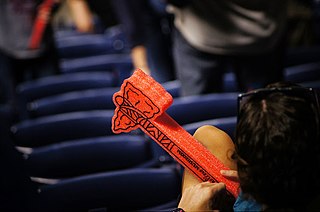
Since the 1960s, the issue of Native American and First Nations names and images being used by sports teams as mascots has been the subject of increasing public controversy in the United States and Canada. This has been a period of rising Indigenous civil rights movements, and Native Americans and their supporters object to the use of images and names in a manner and context they consider derogatory. They have conducted numerous protests and tried to educate the public on this issue.

Inuit are a group of culturally and historically similar Indigenous peoples traditionally inhabiting the Arctic and subarctic regions of North America, including Greenland, Labrador, Quebec, Nunavut, the Northwest Territories, Yukon (traditionally), Alaska, and Chukotsky District of Chukotka Autonomous Okrug, Russia. Inuit languages are part of the Eskimo–Aleut languages, also known as Inuit-Yupik-Unangan, and also as Eskaleut. Inuit Sign Language is a critically endangered language isolate used in Nunavut.
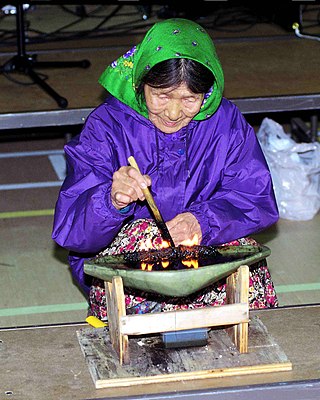
The Inuit are an indigenous people of the Arctic and subarctic regions of North America. The ancestors of the present-day Inuit are culturally related to Iñupiat, and Yupik, and the Aleut who live in the Aleutian Islands of Siberia and Alaska. The term culture of the Inuit, therefore, refers primarily to these areas; however, parallels to other Eskimo groups can also be drawn.
The following is an alphabetical list of topics related to Indigenous peoples in Canada, comprising the First Nations, Inuit and Métis peoples.

The portrayal of Indigenous people of the Americas in popular culture has oscillated between the fascination with the noble savage who lives in harmony with nature, and the stereotype of the uncivilized Red Indian of the traditional Western genre. The common depiction of Indigenous Americans and their relationship with European colonists has changed over time. Today indigenous Americans are fully modern peoples who retain much of their cultural beliefs and traditional practices.
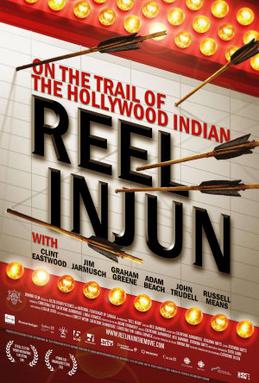
Reel Injun is a 2009 Canadian documentary film directed by Cree filmmaker Neil Diamond, Catherine Bainbridge, and Jeremiah Hayes that explores the portrayal of Native Americans in film. Reel Injun is illustrated with excerpts from classic and contemporary portrayals of Native people in Hollywood movies and interviews with filmmakers, actors and film historians, while director Diamond travels across the United States to visit iconic locations in motion picture as well as American Indian history.

The portrayal of Native Americans in television and films concerns indigenous roles in cinema, particularly their depiction in Hollywood productions. Especially in the Western genre, Native American stock characters can reflect contemporary and historical perceptions of Native Americans and the Wild West.
Lisa Charleyboy is a First Nations (Tsilhqot’in) writer, storyteller, editor, and social entrepreneur. She is the editor-in-chief of Urban Native Magazine, which focuses on popular culture from an Indigenous perspective. She makes frequent appearances on radio and television, promoting her magazine and giving her opinion on current Aboriginal issues in Canada. Charleyboy has said in interviews that she considers herself a feminist and that she wants to provide positive representations of Aboriginal people in her magazine.
In 2005 the National Collegiate Athletic Association (NCAA) distributed a "self evaluation" to its member institutions for teams to examine the use of potentially offensive imagery with their mascot choice. This examination was done in accordance with NCAA policy that requires each member institution to maintain an "atmosphere of respect for and sensitivity to the dignity of every person." Fourteen schools either removed all references to Native American culture or were deemed not to have references to Native American culture as part of their athletics programs. Subsequently, 19 teams were cited as having potentially "hostile or abusive" names, mascots, or images, that would be banned from displaying them during post-season play, and prohibited from hosting tournaments.

The Chicago Blackhawks name and logo controversy refers to the controversy surrounding the name and logo of the Chicago Blackhawks, a National Hockey League (NHL) ice hockey team based in Chicago, Illinois. The use of terms and images referring to Native Americans/First Nations as the name or mascot for a sports team without permissions from or consultations with local Indigenous communities, is a topic of public controversy in the United States and Canada. Since the 1960s, as part of the indigenous civil rights movements, there have been a number of protests and other actions by Native Americans and their supporters targeting the more prominent use of such names and images by professional franchises such as the Cleveland Guardians formerly known as the "Indians" of Major League Baseball (MLB) that was officially discontinued in 2016; the Washington Commanders formerly known as the "Redskins" of the National Football League (NFL), the NFL's Kansas City Chiefs and MLB's Atlanta Braves, the latter two attracting criticism of "the tomahawk chop" often performed by their fans. Like other teams with tribal mascots, there are calls from Indigenous activists and organizations to change the Blackhawks' name and logo and eliminate tribal mascots and imagery throughout sports. In contrast to generic names used by other teams, Blackhawks refers to a World War I-era U.S. Army division which was named for prominent Illinois-based Native American chief Black Hawk.















